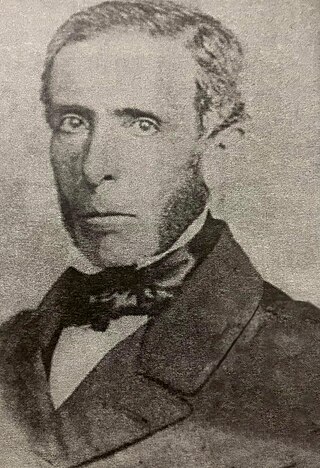
José María Linares Lizarazu was a Bolivian lawyer and politician who served as the 13th president of Bolivia from 1857 to 1861. Commencing his political career at a young age, he emerged as a fervent advocate of free trade, liberalism, the exploitation of silver mines, and the establishment of a monopoly on mercury to facilitate the latter objective.

José Ballivián Segurola was a Bolivian general during the Peruvian-Bolivian War. He also served as the ninth president of Bolivia from 1841 to 1847.
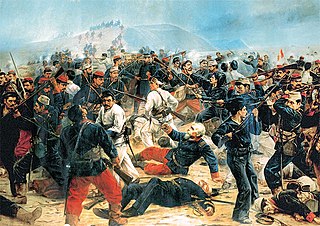
The Battle of Arica, also known as Assault and Capture of Cape Arica, was a battle in the War of the Pacific. It was fought on 7 June 1880, between the forces of Chile and Peru.
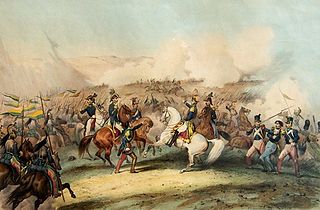
The Battle of Ingavi occurred on November 18, 1841, during the Peruvian-Bolivian War of 1841-1842, in the town of Ingavi, Bolivia. The Bolivian Army, commanded by Jose Ballivian, there met an invading Peruvian Army commanded by Agustín Gamarra, who later died during the battle.
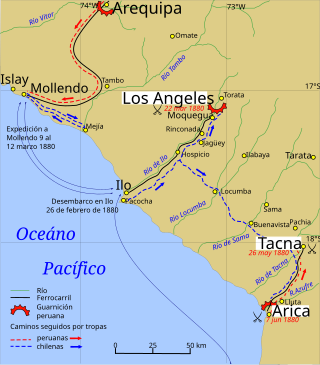
The Tacna and Arica campaign is known as the stage of the War of the Pacific after the Chilean conquest of the Peruvian department of Tarapacá, ending with Chilean domination of the Moquegua department in southern Peru. During this campaign Bolivia retired from the war after the Battle of Tacna, and Peru lost the port of Arica. Also, Manuel Baquedano assumed command as the new Commander in Chief of the Chilean Army, and the Allied Presidents were thrown out of office and replaced by Nicolas de Pierola in Peru and General Narciso Campero in Bolivia.

Tarapacá was a Department of Peru, which existed between 1878 and 1884, when it was unconditionally ceded to Chile after the War of the Pacific under the Treaty of Ancón.

After the naval campaign of the War of the Pacific was resolved, the Chilean terrestrial invasion began.

The invasion of the Iberian Peninsula from 1807 to 1808 by Napoleon Bonaparte's forces proved to be critical for the independence struggle in South America, during which the local elites of Upper Peru mainly remained loyal to Spain, supporting Junta Central, a government which ruled in the name of the overthrown king Ferdinand VII of Spain. Many radical criollos in 1808-10 began a local power struggle. Pedro Domingo Murillo proclaimed an independent state in Upper Peru in the name of King Ferdinand VII. During the following seven years, Upper Peru became the battleground between the armed forces of independent United Provinces of the Río de la Plata and royalist troops from Viceroyalty of Peru.
Events in the year 1841 in Bolivia.

Pedro Bustamante y García (1825-1885) was a Peruvian Brigadier General of the War of the Pacific. He served as the Minister of War and Navy throughout various presidencies during the 1860s and 1870s. He was also known as the main commander during the Siege of Arequipa where he defeated the Conservative forces of Manuel Ignacio de Vivanco.
The Battle of Locumba was a battle of the Tacna and Arica campaign of the War of the Pacific that took place on April 1, 1880, between the Chilean cavalry and the Peruvian garrison at the town.
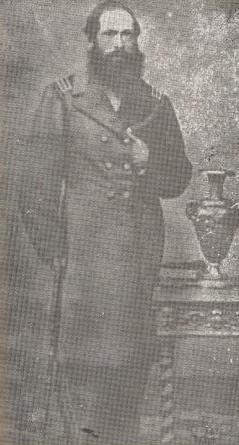
Gregorio Albarracín Lanchipa was a Peruvian Colonel and War Hero who participated in the Peruvian-Bolivian War of 1841-1842, the Peruvian Civil War of 1843–1844, the Peruvian Civil War of 1856–1858 and the War of the Pacific. He is known as El Centauro de las Vilcas as he was notable for using a vilca, a typical tree from Tacna, as a pole to raise the Peruvian flag during the Chilean administration of the area.
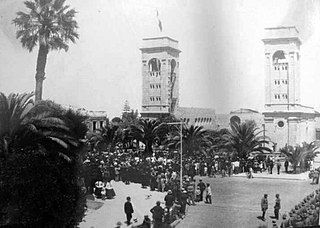
The handover of Tacna from Chile to Peru took place on August 28, 1929. The event ended 49 years of Chilean rule over its then newest province, which began in 1880 after the Bolivian–Peruvian defeat at the Battle of Tacna against the Chilean Army during the War of the Pacific.
The Battle of Buenavista was a battle of the Tacna and Arica campaign of the War of the Pacific on April 18, 1880, between a Chilean cavalry detachment led by Commander José Francisco Vergara, and the forces of Colonel Gregorio Albarracín in the Sama River, Tacna Province, Peru.

Martiniano Urriola Guzmán was a Chilean colonel of the War of the Pacific. He participated across many campaigns of the war as well as being one of the primary commanders of the Chilean North Operations Army.

The Bolivian–Peruvian territorial dispute was a territorial dispute between Bolivia and Peru that lasted from the former's independence in 1825 to the signing of the Polo–Bustamante Treaty in 1909.

The Restoration, known within the context of the dissolution of the Peru–Bolivian Confederation as the Second Provisional Government, was the period in Peruvian history following the reestablishment of a united Peruvian state after the War of the Confederation and prior to the period of military anarchy, lasting from 1839 to 1841.

The name of Military Anarchy is given to the period of the republican history of Peru following the death of President Agustín Gamarra during his failed invasion of Bolivia on November 18, 1841. It was a period of chaos and political and social upheaval, where no government was consolidated.
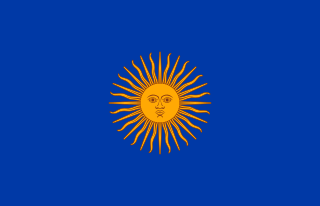
The Department of the Litoral, also known as the Department of Tacna, was a department originally part of South Peru, a constituent country of the Peru–Bolivian Confederation, which existed from 1836 to 1839. Created alongside the confederate state, its capital was Tacna, the capital city of the confederation. After the state's dissolution, it continued to exist as part of Peru until the creation of the Department of Moquegua in 1857.

The Recapture of Tarapacá or Siege of Tarapacá was a confrontation between Bolivian occupation forces under the command of Colonel José María García and Peruvian militias under the command of Major Juan Buendía within the framework of the War between Peru and Bolivia between January 6 and 7, 1842. Peruvian victory allowed us to recover the province of Tarapacá, which had been captured by Bolivian troops days before.














